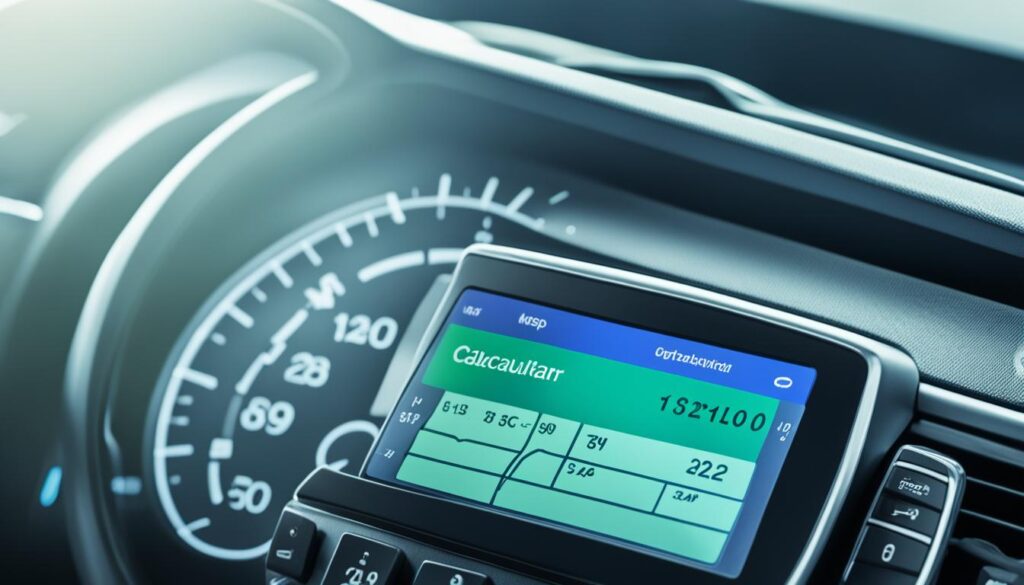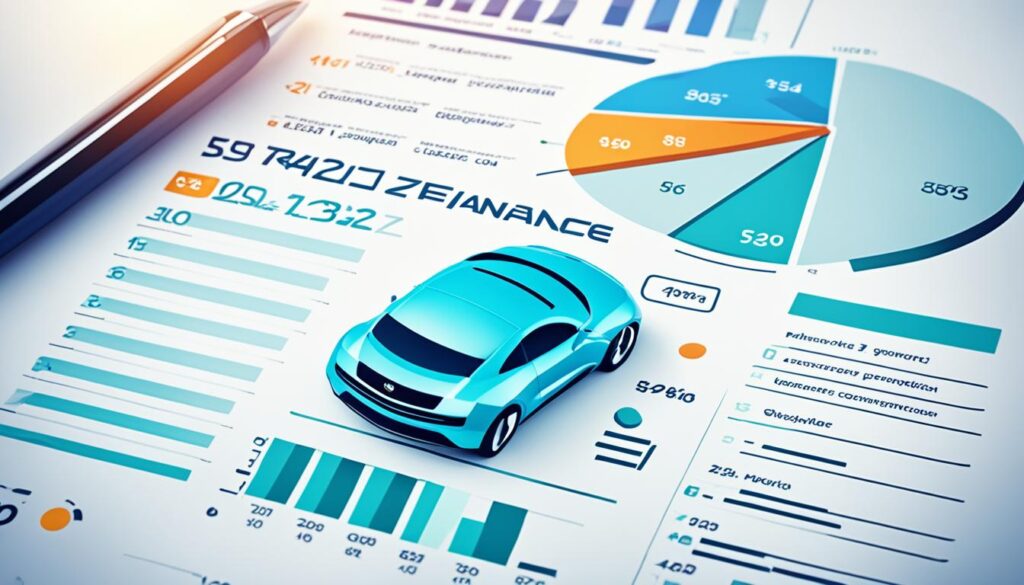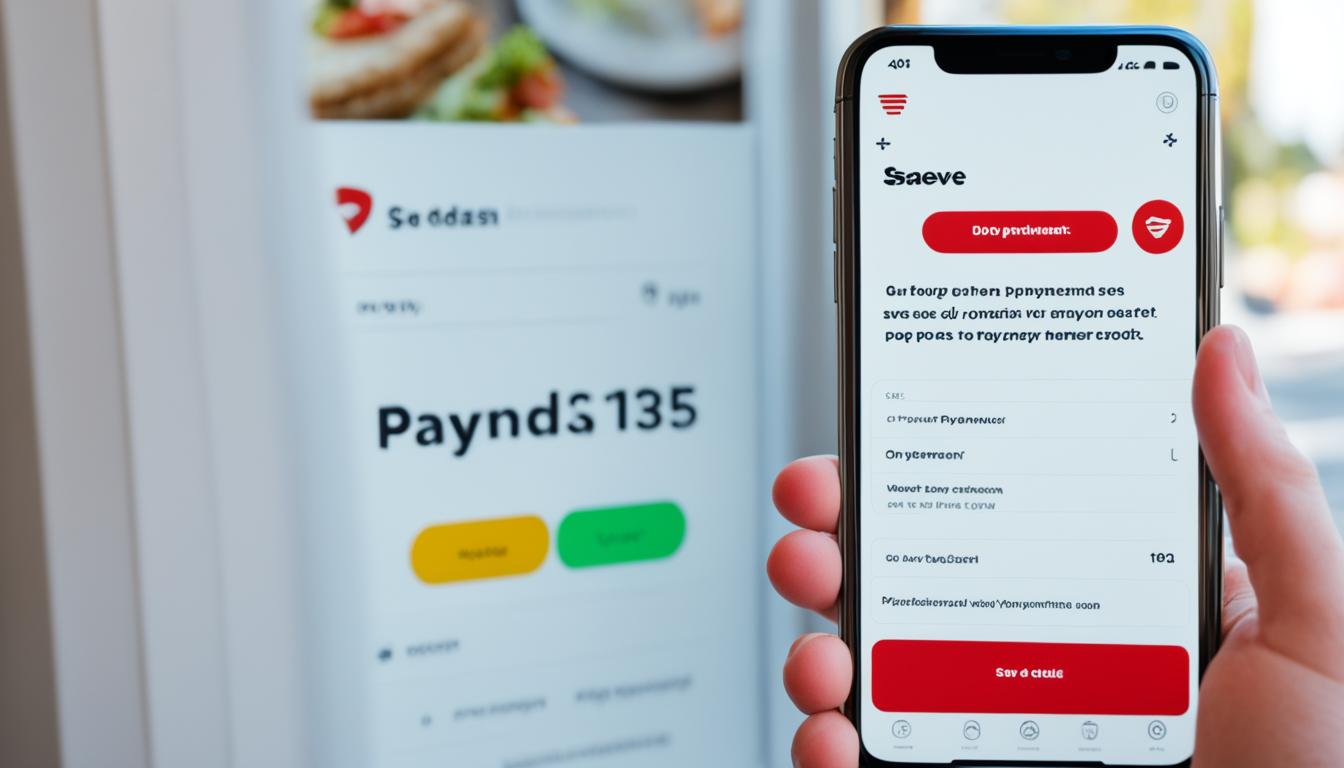Were you aware that the average new car loan in the United States amounts to around $36,000? Given the significant financial obligation involved, it is essential to understand how to calculate car payments correctly. Determining your monthly car payments is vital for financial planning and ensuring you can comfortably afford your vehicle. Fortunately, there are tools like car payment estimators and auto loan calculators available to streamline this process. Let’s explore the details and discover how to easily calculate car payments.
Key Takeaways:
- Calculating car payments is crucial when buying a car.
- Car payment estimators and auto loan calculators can simplify the process.
- Consider factors such as loan amount, interest rate, and loan term.
- Down payments and trade-in values can impact monthly payments.
- Research and compare offers to find the best loan terms.
Factors Affecting Car Loan Payments
Calculating car loan payments involves considering several key factors that can impact the affordability of your loan. By understanding these factors and utilizing a car payment estimator, you can estimate your monthly payments accurately. Let’s explore the factors that influence car loan payments in detail:
- Loan Amount: The total amount you borrow to purchase the car affects your monthly payments. A higher loan amount generally leads to higher payments.
- Interest Rate: The interest rate determines the cost of borrowing money. A higher interest rate will result in higher monthly payments.
- Loan Term: The duration of the loan, typically expressed in months, affects your monthly payments. A longer loan term may result in lower payments, but you’ll pay more in interest over time.
- Down Payment or Trade-In Value: Making a down payment or using a trade-in value can lower the loan amount and reduce your monthly payments.
Considering these factors when estimating your car loan payments is crucial to ensure you can afford the monthly expenses. Let’s take a closer look at each factor:
Loan Amount
The loan amount is the total sum you borrow from a lender to finance your car purchase. It includes the purchase price of the vehicle, taxes, and other fees. The loan amount directly affects your monthly payments.
Interest Rate
The interest rate is the percentage of the loan amount that you’ll pay as interest over the loan term. A higher interest rate leads to higher monthly payments. It’s crucial to shop around for the best interest rates to minimize your expenses.
Loan Term
The loan term refers to the length of time you have to repay the loan. Typically, longer loan terms result in lower monthly payments but may increase the total amount paid in interest over time. Shorter loan terms may have higher payments but save you money in interest.
Down Payment or Trade-In Value
Making a down payment or trading in your current vehicle can significantly impact your car loan payments. A larger down payment reduces the loan amount, resulting in lower monthly payments. Similarly, a trade-in value can be applied towards the purchase price, decreasing the loan amount and lowering your monthly expenses.
Estimating your car loan payments requires careful consideration of these factors. By using a car payment estimator or calculator, you can input the relevant values to calculate your estimated monthly payments. This helps you plan your budget effectively and make informed decisions when purchasing a car.
| Factor | Description |
|---|---|
| Loan Amount | The total amount borrowed for purchasing a car, including taxes and fees. |
| Interest Rate | The percentage of the loan amount charged as interest over the loan term. |
| Loan Term | The length of time you have to repay the loan. |
| Down Payment or Trade-In Value | The amount paid upfront or the value of your current vehicle applied towards the purchase, reducing the loan amount. |
Understanding Interest Rates
When it comes to calculating car payments, the interest rate is a critical factor that you need to consider. The interest rate represents the percentage of the loan amount that you’ll pay as interest over the loan term. It has a direct impact on your monthly payments, as a higher interest rate means higher payments.
To accurately estimate your car payments, you must know the interest rate offered by the lender. You can obtain this information by contacting the lender directly or conducting online research to compare rates from different lenders.

Why Do Interest Rates Matter?
Understanding interest rates is essential because they can significantly affect the affordability of your car loan. By knowing the interest rate, you can calculate the monthly payments and plan your budget accordingly. It’s important to consider the interest rate carefully, as it can have a long-term financial impact throughout the life of the loan.
When comparing interest rates, an even a slight difference can have a substantial effect on your monthly payments. Therefore, it’s essential to shop around and find the best interest rate possible. Even a small reduction in the interest rate can result in significant savings over the course of the loan. Keep in mind that your credit score also plays a role in the interest rate you’re offered, so maintaining a good credit score can help secure the most favorable rate.
Calculating Interest and Principal
When you make monthly car payments, a portion goes towards the principal amount, which is the original loan amount, and another portion is applied to the interest. In the initial stages of the loan, a larger portion of the payment goes towards interest, gradually shifting more towards the principal as you make payments over time. It’s important to understand this breakdown to better comprehend how your payments contribute to paying off the loan.
Factors Influencing Interest Rates
Interest rates can be influenced by a variety of factors, such as the state of the economy, inflation rates, and the lender’s assessment of risk. Different lenders may offer different rates based on their individual criteria. Additionally, factors like the loan term, loan amount, and your creditworthiness can also impact the interest rate you’re offered. By understanding these factors, you can make informed decisions when comparing loan offers.
Loan Term and Monthly Payments
When considering a car loan, it’s essential to understand the loan term and how it impacts your monthly payments. The loan term refers to the duration over which you’ll repay your car loan, usually expressed in months. Your choice of loan term can have a significant effect on your budget and overall affordability.
If you opt for a longer loan term, you’ll enjoy lower monthly payments, making it easier to fit the payments into your monthly budget. However, it’s important to note that a longer loan term may result in paying more total interest over the life of the loan. It’s a trade-off between lower monthly payments and potentially higher overall costs.
Conversely, choosing a shorter loan term will mean higher monthly payments, which could put a strain on your budget. However, taking a shorter loan term can help you save money on interest charges, as you’ll clear the loan faster. You’ll also own your car outright sooner, which provides greater financial flexibility in the long run.
When considering the loan term, it’s crucial to assess your financial situation and priorities. Reflect on your income, expenses, and financial goals to determine what loan term aligns best with your circumstances. Consider factors such as your monthly budget, savings goals, and any other financial commitments you may have.
Comparing Loan Terms
Let’s take a look at a comparison between different loan terms to see how they affect monthly payments. For this example, let’s assume a $20,000 car loan with an interest rate of 5%:
| Loan Term (Months) | Monthly Payment | Total Interest Paid |
|---|---|---|
| 36 | $599.42 | $1,179.12 |
| 48 | $453.21 | $1,570.08 |
| 60 | $365.59 | $1,978.40 |
In the table above, you can see that as the loan term increases, the monthly payment amount decreases. However, the total interest paid over the life of the loan increases. On the other hand, with a shorter loan term, the monthly payment amount increases, but the total interest paid decreases. This demonstrates the relationship between loan term, monthly payments, and overall cost.

By considering your financial situation, priorities, and the loan terms available to you, you can make an informed decision about the loan term that suits your needs. Whether you prioritize lower monthly payments over the long term or aim to minimize total interest paid, choosing the right loan term is a crucial step in managing your car loan effectively.
Down Payment and Trade-In Value
Making a down payment or trading in your current vehicle can have a significant impact on your car loan payments. These options provide opportunities to lower the loan amount and potentially reduce your monthly payments. Let’s explore how down payments and trade-in values can affect the affordability of your car loan.
Down Payments: Reducing the Loan Amount
A down payment is a lump sum of money paid upfront towards the purchase price of the vehicle. By making a larger down payment, you can decrease the loan amount, resulting in lower monthly payments. This can be beneficial in terms of affordability and reducing the amount of interest paid over the life of the loan.
Let’s consider an example: If you’re purchasing a car for $20,000 and you make a down payment of $5,000, the loan amount would be $15,000. With a lower loan amount, you can negotiate better loan terms, such as a lower interest rate, which can further reduce your monthly payments.
When deciding on the ideal down payment amount, consider your budget and financial goals. Saving up for a larger down payment can help you secure a more favorable loan and potentially save money in the long run.
Trade-In Value: Applying it to the Purchase Price
If you currently own a vehicle, you may have the option to trade it in when purchasing a new car. The trade-in value is the amount that the dealership is willing to pay for your current vehicle. This value can be applied towards the purchase price of the new car, effectively reducing the loan amount.
Trading in your vehicle can have a similar impact as making a down payment. By reducing the loan amount, your monthly payments can become more manageable. Additionally, trading in a vehicle can save you the hassle of selling it privately and provide a convenient way to transition into a new car.
It’s important to note that the trade-in value offered by the dealership may not always align with the estimated market value of your current vehicle. Researching the market value beforehand can give you a better idea of what to expect and ensure you’re getting a fair deal.
Utilize a Car Payment Calculator for Clear Estimates
Calculating the exact impact of down payment and trade-in value on your monthly payments can be complex, considering other factors such as interest rates and loan terms. To simplify this process and get precise estimates, it’s recommended to use a car payment calculator.
A car payment calculator is a valuable tool that allows you to input your specific details and instantly see how different down payments and trade-in values affect your monthly payments. This helps you make informed decisions based on your budget and financial goals.
With the help of a car payment calculator, you can experiment with various scenarios and find the down payment and trade-in value that best aligns with your desired monthly payment amount.

“Making a substantial down payment or trading in your current vehicle can significantly impact your car loan payments. Not only can these options help lower the loan amount, but they also provide opportunities to negotiate better loan terms. Utilize a car payment calculator to estimate the impact and find the optimal down payment and trade-in value for your financial situation.”
Comparing New and Used Cars
When it comes to buying a car, one of the biggest decisions you’ll face is whether to go for a new or used vehicle. This choice not only impacts the overall cost of the car, but it also influences your car loan payments. Let’s take a closer look at the factors to consider when comparing new and used cars.

Price and Affordability
One of the primary advantages of buying a used car is that they generally have lower purchase prices compared to new vehicles. This means that the loan amount for a used car will be smaller, leading to potentially lower monthly payments. Used cars can be a more affordable option, especially if you are on a tight budget or looking for a specific make and model that fits your needs.
On the other hand, new cars often come with higher price tags due to their fresh condition, advanced features, and updated technology. Purchasing a new car can result in larger loan amounts and potentially higher monthly payments. However, new cars may come with manufacturer warranties and the latest safety features, providing peace of mind and reducing potential repair costs.
Depreciation and Resale Value
Another factor to consider is the depreciation of a new car. New cars tend to lose a significant portion of their value within the first few years of ownership. This means that if you decide to sell or trade-in your new car down the line, it may not retain its original value. On the other hand, used cars have already gone through the initial depreciation, so their resale value might be more stable.
Condition and Warranty
When comparing new and used cars, it’s important to consider their condition and warranty coverage. New cars are in pristine condition and often come with comprehensive warranties that protect against unexpected repairs. This can provide valuable peace of mind and potentially save you money on maintenance and repairs in the early years of owning the car.
Used cars, on the other hand, may have varying conditions depending on their age, mileage, and previous ownership. It’s crucial to thoroughly inspect a used car and consider obtaining a vehicle history report to ensure there are no hidden issues. While used cars may not come with the same level of warranty coverage as new cars, you can often find certified pre-owned vehicles that offer extended warranty options for added protection.
Using a Car Payment Estimator
One of the best ways to compare new and used cars is by using a car loan payment estimator. These online tools allow you to input the loan amount, interest rate, and loan term to calculate the estimated monthly payments for both new and used cars. By comparing the payment amounts, you can determine which option aligns better with your budget and financial goals.
“When comparing new and used cars, it’s crucial to consider factors such as price, depreciation, condition, and warranty coverage. Utilizing a car payment estimator can help you make an informed decision based on your budget and financial goals.” – John Smith, Car Financing Expert
Ultimately, the choice between a new or used car depends on your personal preferences, financial situation, and priorities. Whether you value the latest features and warranty coverage of a new car or the affordability and potentially lower monthly payments of a used car, consider your needs and conduct thorough research before making a decision.
Buying vs. Leasing
When it comes to acquiring a vehicle, one important decision you’ll need to make is whether to buy or lease. Both options have their advantages and considerations, so it’s essential to evaluate your financial goals and preferences to decide which path is right for you.
If you choose to buy a car, you’ll need to determine the car loan amount you require. By calculating the loan amount, you’ll have a better understanding of how much financing you’ll need. This can be done by considering the purchase price of the vehicle, subtracting any down payment or trade-in value, and adding applicable taxes and fees.
The Advantages of Buying
Buying a car offers several benefits. First and foremost, you become the owner of the vehicle. This means you have the freedom to customize it to your liking and drive it for as long as you desire. Additionally, once the auto loan is fully repaid, you will no longer have monthly car payments, providing you with a sense of financial freedom. Moreover, as the owner, you can sell the car whenever you choose, allowing you to recoup some of your investment.
The Advantages of Leasing
Leasing a vehicle, on the other hand, has its own advantages. When you lease, you’re essentially renting the car for a specific period, typically around two to four years. This can result in lower monthly payments compared to buying a car. Additionally, leasing allows you to drive a newer car more frequently, as leases typically come with shorter terms. This can provide you with the opportunity to experience the latest features and technologies without committing to long-term ownership.
However, it’s important to keep in mind that leasing comes with certain conditions and limitations. Mileage restrictions are common, and excessive mileage can lead to additional charges. Additionally, customization options may be limited, as the leased vehicle needs to be returned in its original condition at the end of the lease term.
Considerations for Determining the Right Option
When deciding between buying and leasing, consider your financial goals and preferences. If you prioritize ownership and the ability to customize your vehicle, buying may be the better choice for you. On the other hand, if you prefer having lower monthly payments and the flexibility to drive a newer car more frequently, leasing may be the more suitable option.
It’s important to calculate the auto loan interest and loan terms carefully and compare them with the costs associated with leasing, such as monthly lease payments and any additional fees. This will help you determine which option aligns best with your budget and lifestyle.
| Buying a Car | Leasing a Car |
|---|---|
| Ownership | Lower Monthly Payments |
| Ability to Customize | Opportunity to Drive a Newer Car More Frequently |
| No Mileage Restrictions | Potential Excess Mileage Charges |
| No Limitations on Modifications | Return Vehicle in Original Condition |
To make an informed decision, evaluate your current financial situation and determine your long-term goals. Consider factors such as your budget, desired vehicle, and driving habits. By carefully weighing the advantages and considerations of buying and leasing, you’ll be able to determine which option is best for you.

Understanding Total Cost of Ownership
When it comes to calculating car payments, it’s important to take into account the total cost of ownership. This encompasses not only your monthly loan payments but also other expenses associated with owning a car, such as insurance, fuel, maintenance, and registration fees. Underestimating these additional costs can lead to financial strain and unexpected surprises.
To get a comprehensive understanding of your car’s affordability, you can use a car cost calculator or a vehicle payment calculator. These tools allow you to input various factors, including your loan terms and estimated non-loan expenses, to provide you with a clearer picture of your overall financial commitment.
An example of a vehicle cost calculator:
| Expense | Monthly Cost |
|---|---|
| Loan Payment | $300 |
| Insurance | $100 |
| Fuel | $150 |
| Maintenance | $50 |
| Registration Fees | $20 |
| Total Monthly Cost | $620 |
By factoring in these additional costs, you can make a more informed decision about your car purchase and ensure it aligns with your budget and financial goals. It’s essential to have a realistic understanding of not just the loan payments, but the complete financial responsibility of owning a car.
Remember, a car payment calculator or vehicle payment estimator can provide valuable insights, allowing you to plan and budget accordingly. Take the time to accurately assess the total cost of ownership to avoid any financial surprises down the road.

Get a Clear Picture of Your Car Expenses
Using a car cost calculator or vehicle payment calculator, you can estimate the expenses associated with owning a car. These tools are designed to provide a comprehensive breakdown of your monthly costs, making it easier for you to manage your finances and make informed decisions. By gaining insight into the total cost of ownership, you’ll be better equipped to choose a car that fits your budget and financial goals.
Impact of Credit Score on Loan Payments
Your credit score has a significant impact on the interest rate you’ll be offered for a car loan. When determining your creditworthiness, lenders consider factors such as your payment history, credit utilization, and length of credit history. A higher credit score generally translates to a lower interest rate, resulting in lower monthly car payments. On the other hand, if you have a lower credit score, you may be charged a higher interest rate, leading to higher monthly payments.
In order to estimate your car loan payments accurately, it’s crucial to take your credit score into account. Before applying for a car loan, it’s a good idea to check your credit score and review your credit report for any inaccuracies or potential areas for improvement. By understanding your credit score and its impact on your loan terms, you can better plan and budget for your monthly car payments.
Improving your credit score is a worthwhile endeavor, as it can save you a significant amount of money over the life of your car loan. By consistently making payments on time, maintaining a low credit utilization ratio, and managing your credit responsibly, you can gradually improve your credit score. In doing so, you may become eligible for better loan terms, resulting in more affordable car payments.
A higher credit score generally leads to lower interest rates and, consequently, lower monthly car payments.
The Importance of Monitoring Your Credit Score
Monitoring your credit score regularly is crucial, not only when you’re planning to take out a car loan but also for overall financial well-being. A good credit score can open doors to better loan terms and interest rates not just for car loans but also for mortgages, credit cards, and other forms of credit. It’s important to be aware of your credit standing and take proactive steps to maintain or improve your credit score.
Some ways to improve and maintain a good credit score include:
- Making all payments on time
- Keeping credit card balances low
- Avoiding opening multiple new credit accounts at once
- Regularly reviewing your credit report for errors
- Using credit responsibly and within your means
By staying on top of your credit score and taking steps to improve it, you can put yourself in the best position to secure favorable loan terms and lower car payments.
Impact of Credit Score on Car Loan Interest Rates
| Credit Score Range | Interest Rate |
|---|---|
| Excellent (800-850) | 2.5% |
| Very Good (740-799) | 3.0% |
| Good (670-739) | 4.5% |
| Fair (580-669) | 7.0% |
| Poor (300-579) | 12.0% |
As shown in the table above, there can be a significant difference in interest rates based on your credit score. It’s important to note that lenders may have slightly different scoring models and criteria for determining interest rates.

By using a car financing calculator, you can input your credit score and other relevant information to estimate your potential monthly car payments. This can help you plan your budget effectively and ensure that you choose a car and loan that align with your financial situation.
Remember, your credit score is not the sole determinant of your loan terms, but it does play a significant role. By understanding the impact of your credit score on loan payments and implementing strategies to improve it, you can set yourself up for more favorable loan terms and more affordable car payments.
Tips for Saving on Car Payments
If you’re looking to save on car payments, there are several strategies you can employ. By implementing these tips, you can potentially reduce the overall cost of your car loan and make your payments more affordable. Here are some key ways to save:
- Save for a Larger Down Payment: Increasing your down payment can lower the loan amount, leading to lower monthly payments. Consider saving up for a larger upfront payment to reduce your financial burden in the long run.
- Shop Around for the Best Rates: Take the time to compare interest rates and loan terms from different lenders. Shopping around can help you find the most competitive rates, ultimately resulting in lower car payments. Use a car loan estimator to compare offers and determine the best option for you.
- Improve Your Credit Score: A higher credit score can potentially lead to better loan terms and lower interest rates. Prior to applying for a car loan, focus on improving your credit score by paying bills on time, reducing debt, and maintaining a low credit utilization ratio. A better credit score can save you money in the form of lower monthly payments.
Note: Remember to consider the long-term financial implications of your car loan. While making lower monthly payments can be beneficial in the short term, it’s essential to evaluate the overall cost of the loan, including the total interest paid over the loan term.
Implementing these tips can help you save money on car payments and make the car finance process more manageable. Now, let’s dive deeper into how these tactics can make a difference in your car loan journey and overall financial well-being.

Strategies for Saving Money on Car Payments
| Strategy | Description |
|---|---|
| Save for a Larger Down Payment | Increasing your down payment can lower the loan amount, resulting in reduced monthly payments. Setting aside funds specifically for a larger down payment can significantly impact your overall car loan expenses. |
| Shop Around for the Best Rates | Comparing interest rates and loan terms from different lenders allows you to find the most affordable option. Utilize car loan estimators and take advantage of online resources to explore various offerings and make informed decisions. |
| Improve Your Credit Score | A higher credit score can lead to better loan terms and lower interest rates. By taking steps to improve your credit score, such as paying bills on time and reducing debt, you can enhance your financial standing and save on car loan payments. |
The Importance of Research and Comparison
When it comes to estimating car payments, conducting thorough research and making comparisons are key. By taking the time to gather information from different lenders and utilizing auto loan payment estimators, you can make informed decisions and find the best loan terms and payment options that align with your budget and financial goals.
Researching various lenders allows you to gain insights into their interest rates, loan terms, and any additional fees or charges. This information provides a comprehensive understanding of the financing options available to you.
Using an auto loan payment estimator further enhances your ability to estimate vehicle payments accurately. By inputting specific details such as loan amount, interest rate, and loan term, these estimators provide you with a clear breakdown of your monthly payments, allowing you to make informed decisions about affordability.
By comparing offers from different lenders, you can identify the loan terms that best suit your needs. This includes not only considering the monthly payment amount but also assessing factors such as the total interest paid over the life of the loan and any potential penalties or fees.
Remember, the goal is to find the loan terms and payment options that not only fit your current financial situation but also support your long-term financial goals.
When conducting your research and making comparisons, consider factors beyond the loan terms and payments alone. Take into account the lender’s reputation, customer reviews, and any additional perks or benefits they may offer. Evaluating these aspects can help you choose a reputable lender that aligns with your values and priorities.
Remember, estimating car payments is an important step in the car-buying process. By conducting thorough research, utilizing auto loan payment estimators, and making informed comparisons, you can confidently navigate the financing options available to you and make a decision that best suits your budget and financial goals.
Loan Terms Comparison
| Lender | Interest Rate | Loan Term (in months) | Monthly Payment | Total Interest Paid |
|---|---|---|---|---|
| Bank A | 5.25% | 48 | $350 | $1,200 |
| Bank B | 4.75% | 60 | $325 | $1,500 |
| Bank C | 4.50% | 72 | $300 | $1,800 |

Considering Maintenance and Future Expenses
Beyond the monthly car loan payments, it’s essential to consider future expenses such as maintenance and repairs. Older vehicles may require more frequent repairs, potentially adding to your overall expenses. It’s wise to budget for these additional costs to ensure you can comfortably afford your car payments.
Regular maintenance is key to keeping your vehicle running smoothly and reducing the risk of costly repairs down the road. Oil changes, tire rotations, and brake inspections are just a few examples of routine maintenance tasks that should be factored into your budget. By staying on top of maintenance, you can prolong the lifespan of your vehicle and minimize the likelihood of unexpected breakdowns.
In addition to routine maintenance, unexpected repairs may arise. Components such as the transmission, engine, or electrical systems can fail, requiring costly repairs or replacement. It’s a good idea to set aside an emergency fund to cover these unexpected expenses.
By budgeting for maintenance and future expenses, you can ensure that you’re prepared to handle the financial responsibilities of owning a car. It’s always better to be proactive and plan ahead rather than being caught off guard by unexpected costs.

Long-Term Financial Planning
Estimating car payments is just one part of long-term financial planning. It’s important to consider how the monthly car payments fit into your overall budget and financial goals. Assess your income, expenses, and savings to maintain a healthy financial outlook. Prioritize saving for emergencies and future financial goals while also managing your car loan payments responsibly.
As you plan for the future, remember that owning a car involves not just the monthly loan payments but also other expenses such as insurance, fuel, maintenance, and registration fees. These costs can add up and impact your overall financial well-being. It’s essential to budget for these additional expenses to ensure that you can comfortably afford your car payments without sacrificing other financial priorities.
Set aside a portion of your income for emergencies and unexpected expenses. Having a financial cushion can provide peace of mind and protect you from financial hardships. Additionally, plan for future goals like saving for a house, education, or retirement. By allocating funds towards your long-term aspirations, you’re taking steps to secure your financial future.
Consider creating a budget to help you track your income and expenses. Identify areas where you can cut back and save money. This might involve reducing discretionary spending, finding ways to save on essentials like groceries, or exploring options for lowering your utility bills. By actively managing your finances and making smart choices, you can create a strong foundation for long-term financial stability.
“A goal without a plan is just a wish.” – Antoine de Saint-Exupéry
Summary of Long-Term Financial Planning:
- Include car loan payments in your overall budget and financial goals
- Assess your income, expenses, and savings
- Prioritize saving for emergencies and future financial goals
- Consider additional car-related expenses such as insurance, fuel, and maintenance
- Create a budget to track your income and expenses

Key Components of Long-Term Financial Planning
| Components | Actions |
|---|---|
| Assessing income, expenses, and savings | Evaluate your financial situation to understand your resources and obligations. |
| Prioritizing savings | Allocate funds for emergencies and long-term financial goals. |
| Budgeting | Create and maintain a budget to track income, expenses, and savings. |
| Managing car loan payments | Ensure car loan payments align with your overall financial plan. |
Conclusion
Estimating car payments is an essential step in the car-buying process, allowing you to plan your budget effectively and make informed decisions. By considering factors such as the loan amount, interest rate, loan term, and down payment, you can calculate your monthly payments accurately.
To ensure you find the best loan terms for your financial situation, it’s crucial to research and compare offers from different lenders. This will help you secure the most favorable interest rates and loan terms, saving you money in the long run.
By carefully planning and budgeting, you can confidently navigate the process of estimating car payments and make a smart financial decision. Whether you’re buying a new or used car, choosing to buy or lease, or considering the total cost of ownership, taking the time to understand the numbers and weigh your options will put you in control of your car financing journey.
FAQ
How can I estimate my car payments?
What factors affect car loan payments?
How does the interest rate affect car payments?
How does the loan term impact monthly payments?
How does the down payment or trade-in value affect car payments?
Should I buy a new or used car?
Should I buy or lease a vehicle?
What is the total cost of ownership?
How does credit score impact car loan payments?
What are some tips for saving on car payments?
How important is research and comparison in estimating car payments?
What should I consider regarding maintenance and future expenses?
How does long-term financial planning relate to estimating car payments?
Can I Use Your Car Payment Calculation Tips if I Take Over Payments on a Car?
Yes, you can use easy car payment takeover tips to calculate the costs of taking over payments on a car. It’s important to factor in the remaining balance, interest rate, and any additional fees. Utilizing these tips can help you make an informed decision before taking over car payments.









